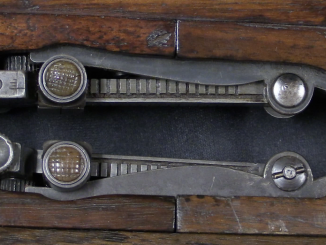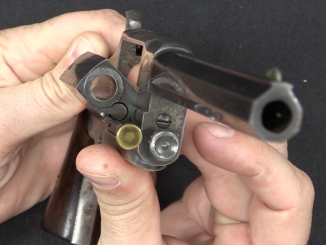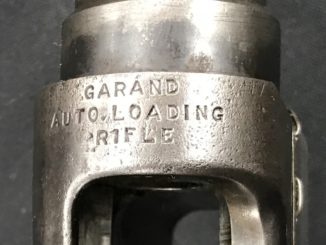Armament Research Services (ARES) is a specialist technical intelligence consultancy, offering expertise and analysis to a range of government and non-government entities in the arms and munitions field. For detailed photos of the guns in this video, don’t miss the ARES companion blog post.
With the British military’s return to Afghanistan in the Global War on Terror, it was found that the very long engagement ranges made it necessary to have a 7.62mm designated marksman’s rifle, in addition to the 5.56mm scoped rifles in service. This was not unique to the British military; the US came to the same conclusion and addressed it by reissuing M14 rifles in new stock systems. The British, however, put out a tender for a new 7.62mm rifle in 2009 (the FAL being not sufficiently accurate to meet this need).
The final contenders for the role were the H&K 417 and the Lewis Machine & Tool LM7 rifle – basically a Stoner SR25 or AR-10 using the original Stoner quasi-direct-impingement action. LMT was chosen as the winner and formally adopted as the L129A1 in October of 2009, with rifles entering field service by May of 2010.
The L129A1 has proven effective and popular enough that the British military is currently looking to expend its role to that of sniper support weapon. This would involve a change in anticipated targets to enemies wearing body armor, which the current 7.62mm projectiles are not particularly good at defeating. A new projectile is in development with a steel penetrator tip (in principle similar to the 5.56mm SS109 projectile) to allow the L129A1 to fill this new role as well.




Hi Ian,
I noticed you mentioned a badge if you put two rounds through the same hole but never showed the target… I take it “No badge for you”. How Far was you shooting?
What a happiness to see a Stoner inline piston rifle without a forward assist.
Not actually a piston system, and it’s about 50/50 these days if an AR-10 pattern gun is going to have a forward assist.
I think that when Strongarm wrote “piston” the reference was to the original Stoner system where the bolt itself is also a piston.
Thanks Matisse.
Once again the Brits seem behind the curve weapons wise. Now that the unique situations presented in Afghanistan are winding down, they come up with a rifle specific to that engagement. Much like the US re-purposing the M14, the Brits might as well have used the old L1A1 to fill the need.
“winding down, they come up with a rifle specific to that engagement”
There are very numerous examples in history of armed forces ready to fight previous war. For example see TOG I:
http://www.tanks-encyclopedia.com/ww2/gb/TOG-I.php
basing on Great War experience it was optimized for trench-crossing, not high speed traveling.
French Renault R35 tank is another example of equipment for previous war.
Your argument falls foul of
Assumptions of;
technological determinism
A single solution to different understandings of a problem
And the logical fallacies of;
Appeal to novelty
Appeal to popularity/bandwagon
I don’t understand – why you use ; sign after of? This imply that your post is de facto three totally independent posts. Or it is not?
Anyway:
For every complex problem there is an answer that is clear, simple, and wrong (quote attributed to H.L.Mencken)
Please understand: this is an English way how to say “ass-backward”. No offence intended. -:)
Base of your comment is right though: militaries are utterly inflexible. Exactly opposite to what real life is.
“old L1A1”
If under L1A1 you mean FAL then notice that fragment:
British, however, put out a tender for a new 7.62mm rifle in 2009 (the FAL being not sufficiently accurate to meet this need)
Shooting matches with SLRs unsupported with iron sights and ball ammo went to 600m. I doubt any effort was put into seeing if they could be made accurate enough for DM work. The Canadians actually threw their old FALs into a damp room in a heap (with the results you’d exppect)and forgot about them until an “artist” needed 1,000 to weld into an anti-violence sculpture.
Canadian military solved need for “sharpshooter” rifle first by ordering bolt action rifles from PGW http://www.pgwdti.com/
and later from Desert Technologies (bullpups).
I do not think they have any semi-autos for that purpose at the moment.
I think Ian describing the L129A1 as a new piece of kit is relative to the sort of stuff he normally covers. Note “formally adopted as the L129A1 in October of 2009” in the description – although it probably would have been welcomed earlier, hardly a case of meeting the requirement when it was nearly gone – Op HERRICK ran for another 4/5 years. I think that’s what was being implied by other comments too
“the sniper-support … dude”
That was hilarious.
Last comment was in reply to Hank.
For some reason, it didn’t go through as a reply
Another example in Afghanistan: the Australians had SR-25 sniper rifles in inventory and tried to push that down to their platoons. It wasn’t suited to sustained infantry work, so they went and brought HK417s (some units borrowed M14s).
Also, I believe New Zealand used precision FN FALs in Afghanistan but they eventually were replaced by Stoner rifles.